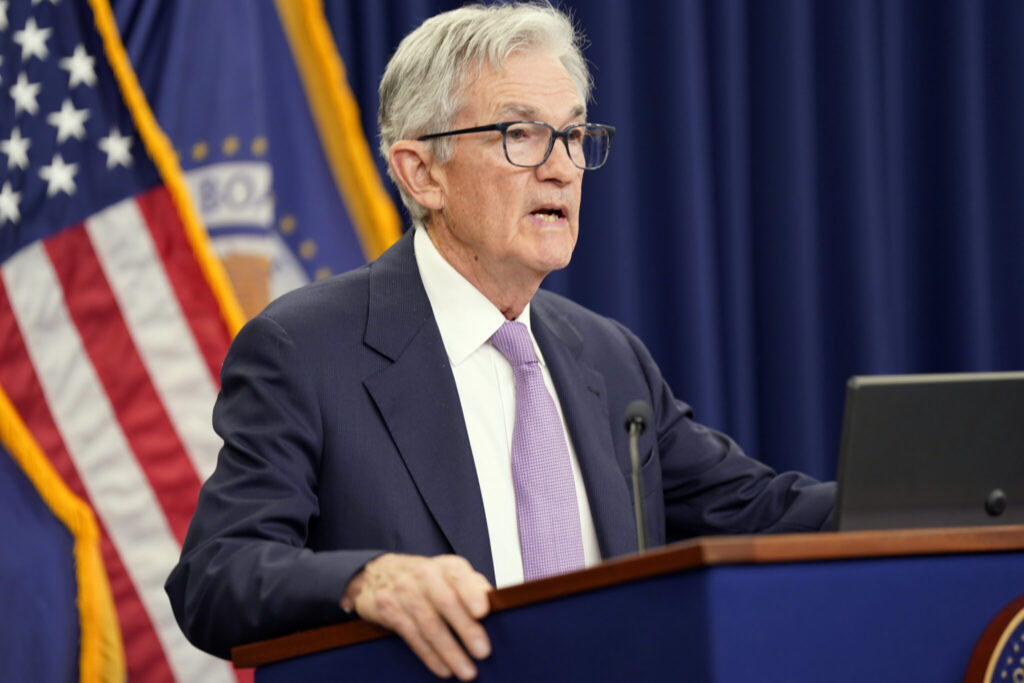
Federal Reserve Bank Chair Jerome Powell speaks Thursday, after the Fed cut the benchmark interest rate by a quarter of a percent. Photo by Kent Nishimura/Getty Images.
The Federal Reserve cut its key rate on Thursday — one of many factors that will decide what kind of economy Americans remember from President Joe Biden’s final days in office and what President-elect Donald Trump is left with at the start of his second term.
The Federal Reserve cut the rate by a quarter of a percentage point, which was in line with economist expectations. The Federal Open Market Committee’s vote was unanimous in favor of the cut. At its previous meeting in September, the Fed cut the rate by a half-point for the first time in four years, as inflation continued to show signs of cooling.
Fed Chair Jerome Powell said that the job market remains solid, that economic activity has continued to expand, and that consumer spending is resilient. He said inflation is close to the Fed’s 2% goal, at 2.1% in September, but core inflation, which excludes food and energy, is still elevated, at 2.7%.
“We continue to be confident that with an appropriate recalibration of our policy stance, strength in the economy and labor market can be maintained with inflation moving sustainably down to 2%,” Powell said.
The Fed’s new benchmark rate is 4.5% to 4.75%. It’s the Fed’s second cut since it paused rates last year following an aggressive rate-hiking campaign to tame inflation. The Fed raised rates 11 times between March 2022 and July 2023.
Dante DeAntonio, labor economist at Moody’s Analytics, said the general public probably won’t feel a significant change from an individual rate cut, but he expects that in the medium-term, the cuts will affect housing and consumer spending.
Rent is eating up a greater share of tenants’ income in almost every state
“I think generally speaking, we should expect to see rates across the spectrum come down from credit card rates to auto loans to mortgages, but that’s not going to happen in a quick way – day-to-day or month-to-month – and it’s not going to make a huge impact,” he said.
The Bureau of Labor Statistics released a less-than-stellar jobs report Friday, showing the labor market added only 12,000 jobs in October. But Powell said Thursday that this mostly reflected strikes and major hurricanes during the month, and that job growth would have been higher if not for those factors.
Trump’s election Tuesday could mean substantial changes for the economy and has implications for the Fed’s own policy choices.
If Trump is able to fully enact ideas he floated while campaigning – such as heavy tariffs on imports from China and mass deportation of immigrants – it could reduce households’ purchasing power and harm the labor supply, some policy experts, researchers and economists say.
Indivar Dutta-Gupta, who focuses on policy research and seminars at Georgetown University’s McCourt School of Public Policy, said Trump’s immigration policies could result in a large reduction of labor supply.
“The economy has benefited and native-born workers have benefited in recent years from the growth in workers coming in from abroad. One would expect that to slow and potentially net in the other direction,” Dutta-Gupta said.
Mark Zandi, chief economist at Moody’s Analytics, said that based on what we know now about Trump’s proposals, the Fed will have to contend with an inflationary environment.
“The policies President Trump espoused on the campaign trail, which include higher broad-based tariffs, mass deportation of unauthorized immigrants already in the country, tax cuts that are largely deficit-financed, and the view that the president should have input into the decision-making process of the Federal Reserve around interest rates – all of that is inflationary,” he said.
This could mean that in the future, it’s less likely the Fed would continue to cut rates and might potentially raise rates.
“It all depends on whether President Trump follows through on those things he said during the campaign, and to what degree and over what period of time. But all of those things are directionally towards higher inflation, which means higher interest rates than otherwise would be the case,” he added.
YOU MAKE OUR WORK POSSIBLE.
Trump has talked on the campaign trail about the possibility of the president having greater “say” over the Fed’s decisions. During his first term in office, he was very vocal in his displeasure with some of the Fed’s interest rate decisions.
In October, Trump said that although he should not be able to order the Fed to make the decisions he favors, “I think I have the right to put in comments as to whether or not the interest rates should go up or down.”
Powell responded Thursday to questions about a second Trump administration’s effect on the independence of the Fed. When asked if the president can demote him or other leadership at the Fed, he said: “Not permitted under the law.”
The Fed is designed to operate on data, not politics.
Powell said the election will have no effects on the Fed’s policy decisions in the near term. He added that the Fed doesn’t yet know the timing or policy substance of the incoming administration.
“We don’t guess, we don’t speculate and we don’t assume,” he said.

